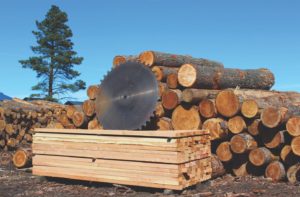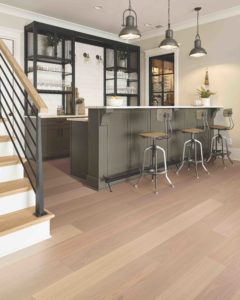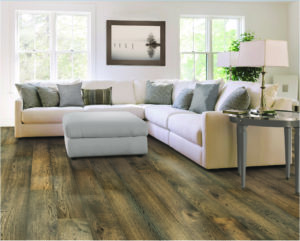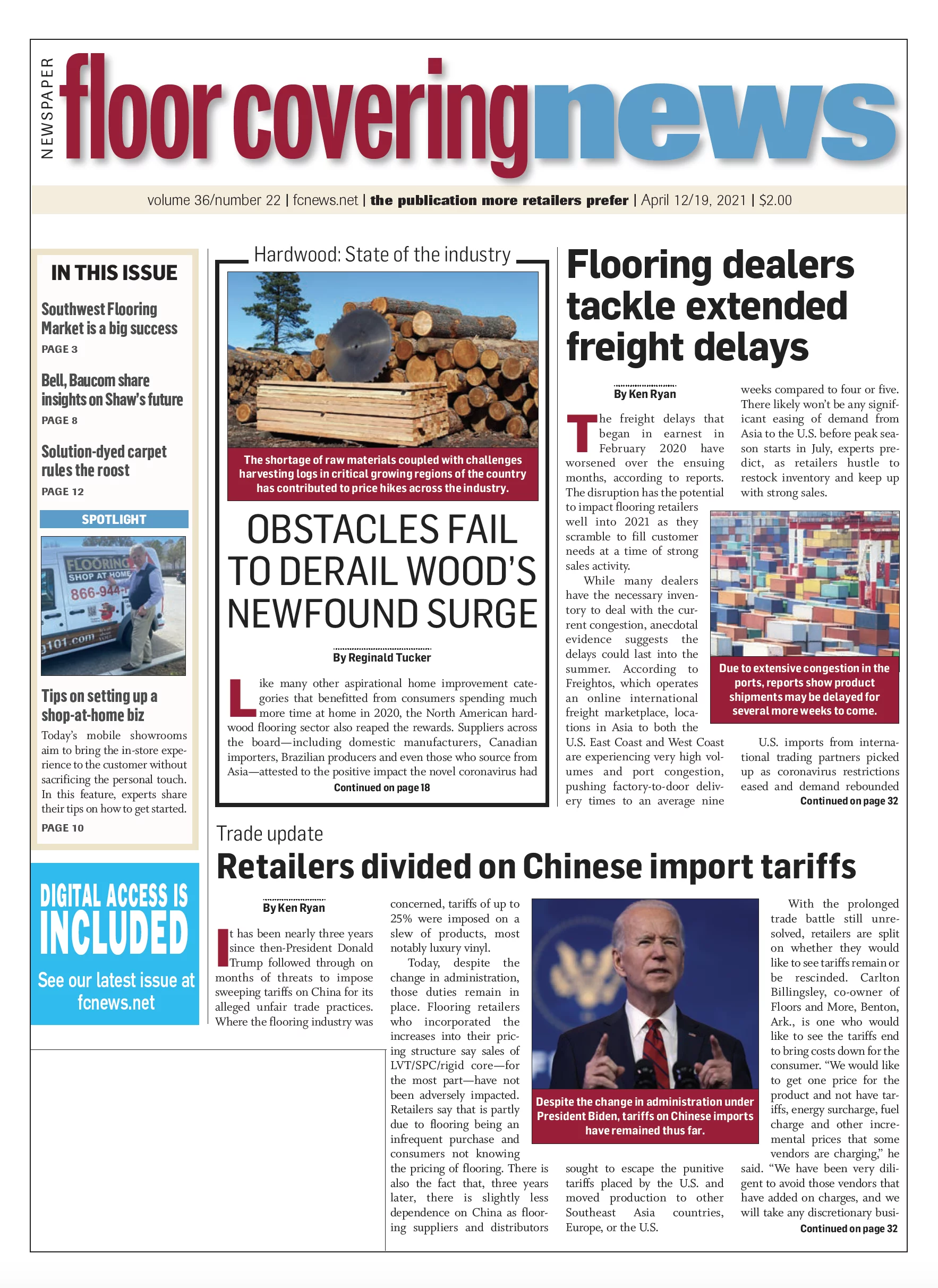
By Reginald Tucker Like many other aspirational home improvement categories that benefitted from consumers spending much more time at home in 2020, the North American hardwood flooring sector also reaped the rewards. Suppliers across the board—including domestic manufacturers, Canadian importers, Brazilian producers and even those who source from Asia—attested to the positive impact the novel coronavirus had on purchases and installations of hardwood flooring in 2020 and beyond.
“With so many people stuck indoors due to COVID-19 restrictions, many have looked for ways to improve and invest in their homes,” said Drew Hash, vice president of hard surface, Shaw Residential. “Hardwood is a highly coveted and sought-after product that adds value and an elevated look to any space. As consumers continue to remodel their homes, we expect to see positive growth trends, especially while some households still have extra discretionary income from sheltering in place.”
Others agreed. For AHF Products, the sectors that are exploding right now are single- family remodel applications and single-family new home construction builds. By its count, about two-thirds of wood sales are residential replacement, with roughly one-third new construction. “Both of them are really, really strong right now in terms of demand,” said Brian Carson, president and CEO. “Hardwood does less well in apartment renovations and is a smaller part of commercial. Both of those segments are off.”
That seems to be the consensus among many of the industry’s main players, Mohawk included. “We’re definitely seeing sales come from the renovation and remodel sector,” said Adam Ward, senior product director, wood and laminate. “The builder channel is strong as well, with housing starts continuing to do well.”
Dan Natkin, vice president, hardwood and laminates, Mannington, also said he sees the bulk of activity happening in residential replacement. “New construction is always a key driver for hardwood consumption; however, residential replacement has been quite robust post-COVID-19 with consumers frequently upgrading their new flooring to hardwood.”
More telling, though, is the types of products that are selling as a result of the pent-up demand. “The high end in both new home construction and the remodeling market are very strong for hardwood today,” said Neil Wenger, vice president of distribution sales at Mullican Hardwood Flooring. “We see wide-width demand in 3⁄4-inch solid hardwood flooring growing with wirebrushed lighter tones garnering the most interest. Buyers who are purchasing larger, more premium homes are choosing hardwood floors for their natural beauty, high-end finishes and products that add value to their home.”

This activity, suppliers report, is not relegated just to select applications. Take Indusparquet’s experience, for example. “Our business tends to be much more focused on residential replacement, but we’re honestly seeing good demand across all those segments of the building market,” said Jodie Doyle, vice president, sales and marketing, U.S. “On the commercial contract segment, we are experiencing really high demand for products for specification. The pipeline, due to COVID-19, had a bit of a lag during the first quarter and into the second quarter, but we expect robust sales and activity for the second half of 2021 and all of 2022.”
Even Canadian suppliers—whose country has put travel limits on people but not durable goods—are seeing robust end-user activity. “We do have a very strong housing market right now,” said Wade Bondrowski, director of sales, USA, Mercier. “Looking at the amount of houses that are turning, people are moving into new homes and adding their own styles. We see that market as well as new home construction as the two driving forces.”
Brad Williams, vice president of sales and marketing at Boa-Franc, maker of the Mirage brand, agreed. “Single-family new construction and residential replacement is driving the growth in the hardwood category,” he said.
Impact of price hikes
While most hardwood suppliers report robust activity among the key, bellwether market segments, there’s another side to the coin. With greater consumer pent-up demand comes a dramatic rise in orders, and a direct result of that is a strain on demand. Couple that with extenuating factors such as blockages and tie-ups at major shipping ports around the country, and you have the recipe for escalating prices.
In just the past few months alone, some of the major hardwood suppliers have announced multiple price hikes on both sourced and locally produced flooring. While some manufacturers strive to absorb the bulk of the costs in order to help their partners throughout the chain remain more competitive, executives say it’s an issue that’s having ramifications. “Price increases are happening as a result of raw material increases and freight, especially things related to lumber and petroleum,” said Don Finkell, CEO of American OEM. “Price increases are also being propelled by a shortage of labor in most wood flooring plants. This puts upward pressure on wages that must be paid.”
Suppliers view this phenomenon as a perfect storm. “Costs in every area of our business are increasing—freight, supplies and parts have all gone up,” Mullican’s Wenger said. “However, the increase in lumber and labor have had the most impact.”
Price increases in the form of raw material inflation is one of the key drivers behind the hikes. “We haven’t seen inflation like this in nearly a decade, particularly on species like white oak and hickory,” Mannington’s Natkin said. “This is driven by higher than expected demand, struggles at the sawmills to staff with COVID-19 precautions and weather-related issues. The winter storms across Texas earlier this year also impacted key components used in wood adhesives and finishes, and that has driven pricing dramatically higher as well.”

Freight, from both Asia and Europe, also remains a bugaboo. “Freight rates have been out of control since late last year,” Natkin added. “The ports are clogged with struggles to offload containers and maintain COVID-19 protocols, which is leading to a global shortage of empty containers.”
Some suppliers are really feeling the price pressures when it comes to specific hardwood species—namely white and red oak. Couple that with challenges associated with harvesting logs in inclement conditions and that just further aggravates the issue. “It’s tough,” Mercier Wood Flooring’s Bondrowski said. “The tricky part is the demand is so strong right now, but we’re in the middle of what we call the ‘fall episode,’ so there’s not as many logs available because they got too wet.”
Mercier, which enacted a price increase in the beginning of the year, warned that another hike may be looming in the near future. “Everything from the cost of the boxes, to the adhesive, to the finish, to the cost of the raw material and the transportation—all facets have moved and are costing suppliers more money.”
AHF Products, which enacted several price increases since last fall, also attested to the effect that a slim lumber supply has on pricing. “Raw materials are tight everywhere,” Carson said. “Specifically in lumber in the United States, some prices have tripled coming out of the pandemic. Logging of hardwood in the United States is also down right now. It’s just a shortage and we have to do what we have to do to go out and get the materials to make the product.”
But it’s the freight issue that’s really concerning for executives. “That’s impacting overseas even more significantly than the United States, like our Cambodia operations,” Carson stated.
It’s not just popular domestic species that are being impacted. Indusparquet, which sources predominantly from South America, is also feeling the pinch. “The raw materials situation is real,” Doyle said. “We manufacture everything we sell in Brazil, which is experiencing high demand and low availability. The freight situation that many are feeling on the West Coast isn’t nearly as pronounced for our shipments, which are mainly coming into Miami and some of the eastern seaboard ports. That said, the issues being experienced out there are causing issues here to a lesser extent.”
Amid all the challenges and complexities that continue to vex hardwood suppliers, some companies are working hard both behind the scenes and alongside their channel partners to alleviate the issue.
“Wet conditions in the Appalachian/U.S. hardwood belt have led to inflation of raw mate- rial prices, but impacts to service have been minimal, or at least manageable, for Shaw,” Hash said. “Our strong relationships with our vendor partners and customer-centric approach to business have enabled us to weather that storm relatively well. Shaw will continue to leverage its strong industry relationships whenever possible to work through this challenge alongside our customers.”
AHF Products’ Carson agreed. “That is the unfortunate situation in which we find ourselves,” he said. “I think it’s going to be with us for a while. Certainly freight and material availability is going to be a challenge for the balance of the year.”
Short-term outlook

Present challenges notwithstanding, many hardwood flooring executives say things are looking up for the industry. They cite, among other things, somewhat of a return to normalcy as vaccines become more widely distributed. They also point to rising consumer confidence, which can only bode well for the home improvement sector at large—and wood flooring in particular.
“March of 2020 brought the pandemic and, with it, a sharp drop in demand for two months,” Shaw’s Hash said. “The market rebounded much quicker than many anticipated, with historic demand in both retail and single-family new construction. While that was positive, it brought unforeseen challenges to workforce logistics, which affected supply as well as global supply chain disruptions. This also impacted the industry’s ability to keep up with ever-increasing demand. We made several strategic adjustments throughout last year that enabled us to see some positive performance in the category for 2020, and we expect that to continue moving into 2021.”
Other executives say they strongly believe the hardwood category is on pace for a strong rebound, despite coming off a tumultuous year. “We think the category retracted 5% to 9% in 2020 vs. 2019,” Boa-Franc’s Williams said. “We predict the hardwood category will reach high-single- to potentially double-digit percentage growth this year. Our preliminary projections for 2021 is the category will expand 8% to 12%.”
Some suppliers say they see a silver lining amid the clouds of uncertainty and unprecedented change the industry experienced in 2020. “We feel there has been a bit of a shift in the market that has been created by both lack of supply and consumer demand for value-added products,” Indusparquet’s Doyle explained. “Our products are obviously a smaller segment of the overall hardwood category, but we are also fielding lots of interest from folks wanting to source products from South America—and Brazil in particular. When you add those demands to a nice uptick in our traditional exotic business, we are primed for a terrific second half of 2021 and beyond.”
Regardless of their competitive positions and respective go-to-market strategies, wood flooring executives say it would be unwise to count out hardwood. Mullican’s Wenger, for example, is not looking back on the wild year that was 2020; instead, he said he’s focusing on opportunities for hardwood today. “Clearly, people are spending more time at home and want quality products,” he said. “Wood is warm and natural and has a classic look and feel. Over the years, other products have attracted attention and market share, but wood is a long-term investment and still the only product we see listed as a value-added feature in the resale market for housing.”

